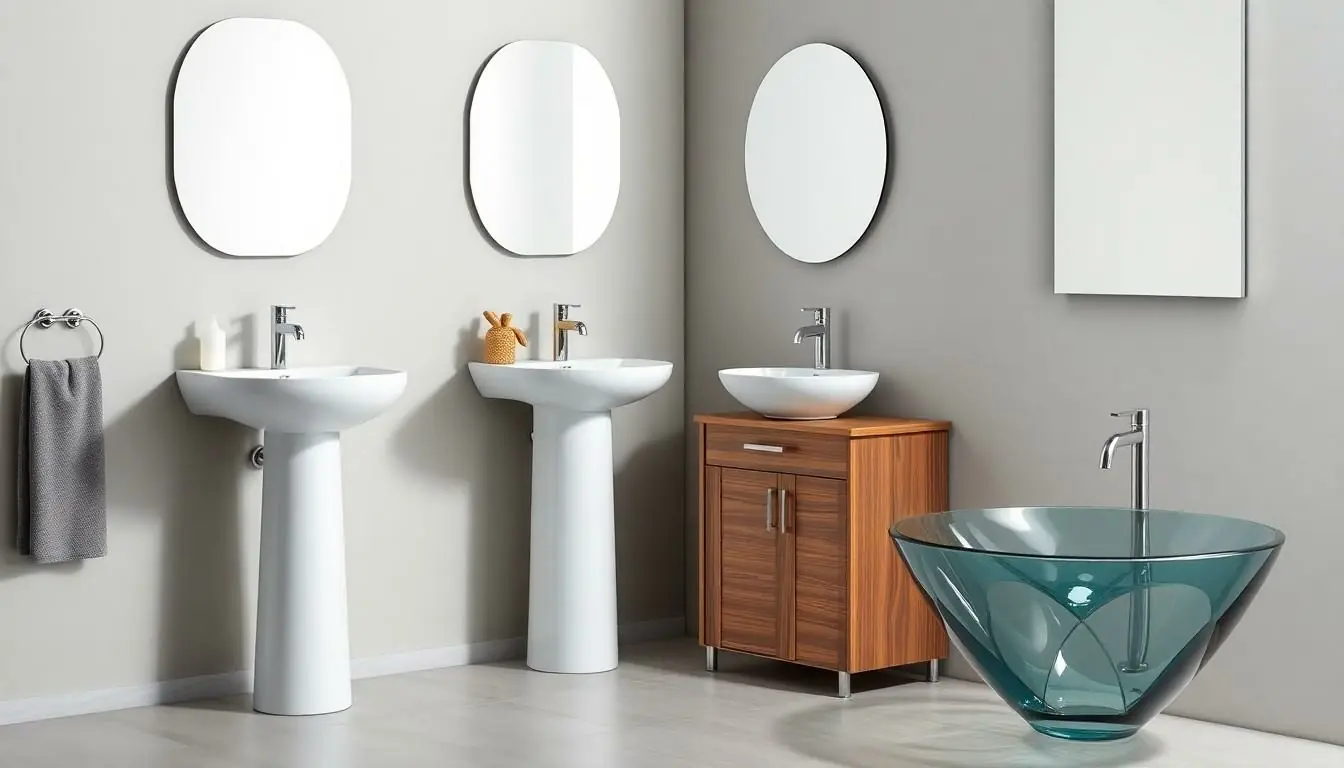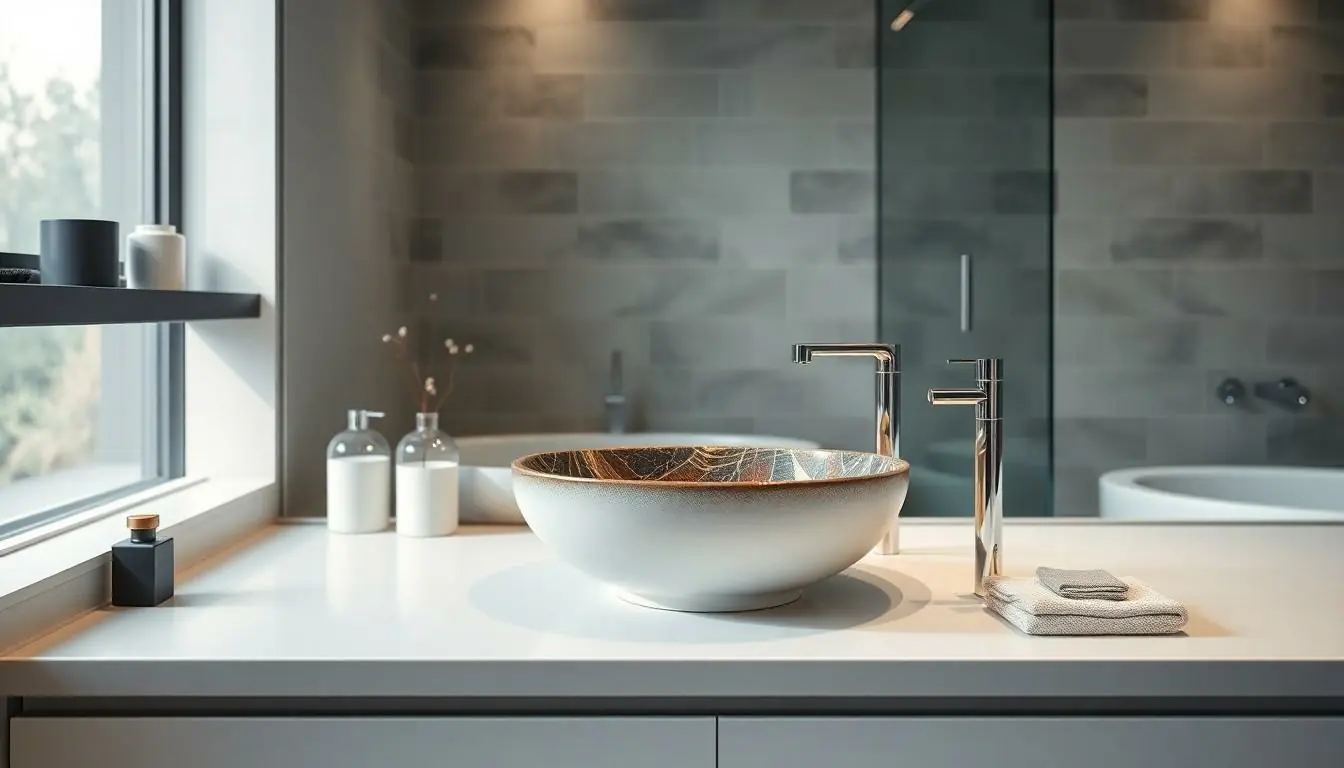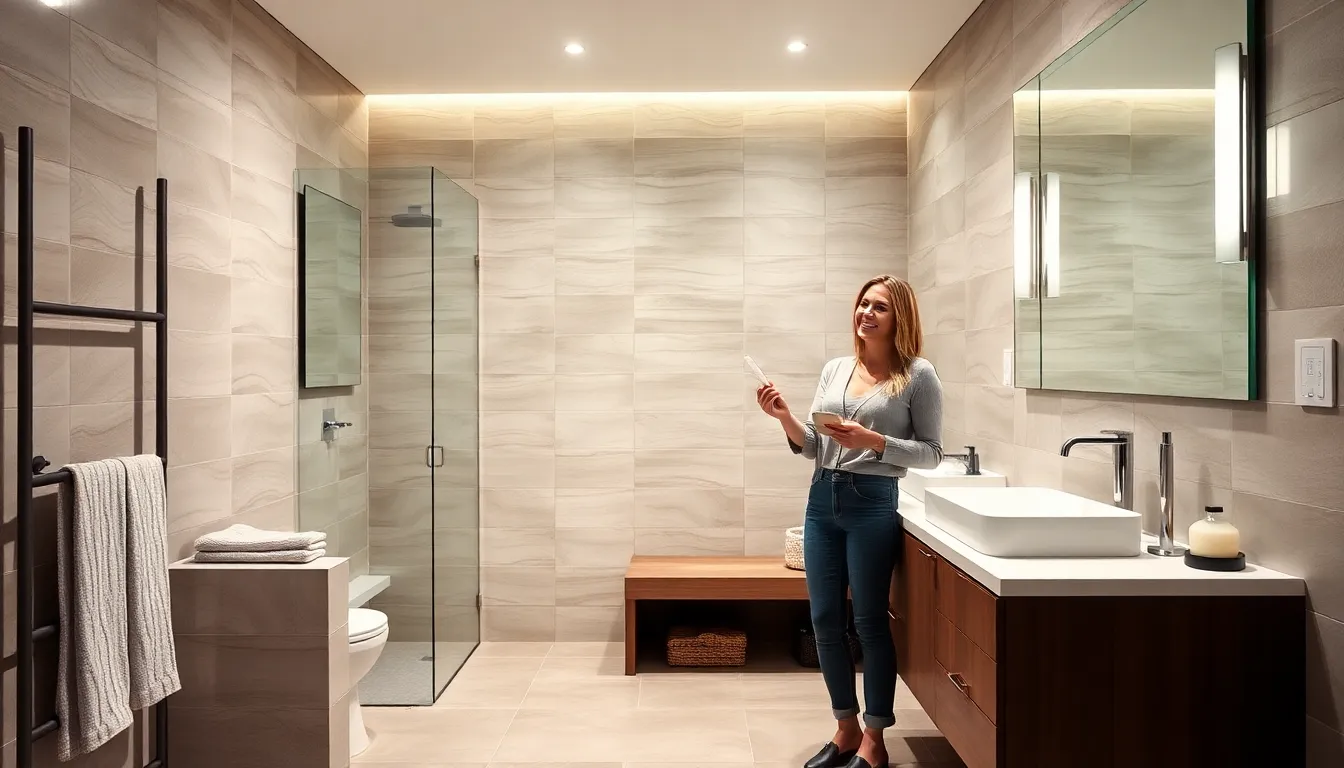When it comes to bathroom design, the sink often gets overlooked, but it’s the unsung hero of daily routines. Think about it: it’s where mornings kick off and nights wind down. A stylish and functional sink can transform a mundane bathroom into a sanctuary.
Choosing the right sink isn’t just about aesthetics; it’s about functionality too. From sleek vessel sinks that scream modern chic to classic pedestal sinks that bring a touch of nostalgia, the options are endless. And let’s be honest, nobody wants a sink that looks like it’s been through a battle with toothpaste and soap scum.
Table of Contents
ToggleOverview of Sinks for Bathrooms
Sinks play a vital role in bathroom functionality and aesthetics. Various styles cater to different preferences and spatial constraints. Vessel sinks sit atop vanities, offering a contemporary appearance. Pedestal sinks provide a classic touch, ideal for smaller spaces. Wall-mounted options save floor space, making them suitable for tight layouts.
Materials also influence selection, as each offers unique benefits. Porcelain and ceramic sinks provide durability and ease of cleaning. Stainless steel options add a modern twist, while glass lifts visual appeal. Natural stone sinks, such as marble or granite, introduce elegance but require more maintenance.
Sizes vary significantly, affecting both design and utility. Standard vanity sinks typically measure 20 to 25 inches wide. Larger models, up to 60 inches, suit more extensive vanities. Choosing the right size ensures proper fit within the overall bathroom layout.
Installation types include undermount, top-mount, and integrated designs. Undermount sinks create a seamless look, ideal for solid surface countertops. Top-mount sinks install easily, making them user-friendly for DIY projects. Integrated sinks combine countertop and sink into a single piece for a sleek appearance.
Functionality matters, with features enhancing user experience. Single or double basin sinks accommodate different needs and preferences. Faucets, drains, and accessories contribute to overall efficiency and ease of use. Selecting the right configuration can significantly impact daily tasks, such as washing hands or brushing teeth.
Ultimately, an ideal bathroom sink balances style, practicality, and personal taste. Exploring various options paves the way for informed decisions in this essential bathroom element.
Types of Sinks for Bathrooms

Bathroom sinks come in various styles, each offering unique benefits. The following sections explore the most popular types of sinks for bathrooms, helping to ensure a choice that aligns with both function and design.
Pedestal Sinks
Pedestal sinks provide a classic look that complements traditional bathroom designs. These sinks consist of a basin mounted atop a freestanding pedestal, creating a clean appearance. Compact size makes pedestal sinks ideal for smaller spaces while still providing essential functionality. Installation typically involves securing the sink to the wall, allowing for easier cleaning around the base. Both porcelain and ceramic materials dominate this sink style, enhancing durability and ease of maintenance.
Wall-Mounted Sinks
Wall-mounted sinks maximize floor space through their unique design, attaching directly to the wall. This type of sink creates an open feel, making it a popular choice for contemporary bathrooms. Various sizes and shapes cater to diverse design preferences while leaving room underneath for storage or additional features. Less plumbing is required compared to traditional sinks, simplifying installation. Materials such as stainless steel and ceramic offer robust options that withstand daily use.
Vanity Sinks
Vanity sinks integrate seamlessly into bathroom cabinetry, providing both style and storage. These sinks are available in single or double basin configurations, accommodating different needs and preferences. Customizable designs allow homeowners to select from an array of materials and styles, enhancing the overall aesthetic. Vanity sinks typically measure between 20 and 25 inches wide, fitting standard vanities easily. The additional counter space provides convenience for toiletries and personal items as well.
Vessel Sinks
Vessel sinks rise above the countertop, showcasing striking designs and materials. These sinks come in unique shapes, such as round, square, or rectangular, allowing for personalized bathroom styles. Installation involves placing the sink atop the counter, making it a visually stunning centerpiece. Options include materials like glass, stone, and ceramic, offering a range of colors and textures. Vessel sinks work well in spacious bathrooms, acting as focal points while offering ample depth for practical use.
Materials Used in Sinks for Bathrooms
Various materials contribute to the functionality and aesthetic appeal of bathroom sinks. Understanding these materials aids in making informed choices.
Ceramic
Ceramic sinks comprise clay and are known for their durability and easy maintenance. Many homeowners appreciate their glossy finish and ability to resist stains. These sinks come in a wide range of colors and styles, allowing for creative design choices. They’re also non-porous, which minimizes mold growth and enhances hygiene. Despite their robust nature, ceramic sinks can chip or crack upon impact, so careful handling is essential. Overall, ceramic remains a popular choice for many bathroom designs.
Stone
Stone sinks present a luxurious option with natural textures and unique appearances. Materials like granite, marble, and soapstone highlight the sophistication of any bathroom. Each stone sink holds its individual pattern, ensuring no two are alike. They offer exceptional durability and withstand heavy use without significant wear. Periodic sealing is necessary to prevent staining and maintain their appearance over time. The natural aesthetic of stone complements various bathroom styles, adding a timeless element to modern and classic designs alike.
Glass
Glass sinks provide a modern and elegant touch to bathroom decor. Available in a variety of shapes and colors, these sinks can act as a stunning focal point. Tempered glass offers enhanced strength, resisting scratches and impacts. Cleaning is straightforward, as smooth surfaces prevent the buildup of grime. However, careful handling is crucial to avoid breakage or chipping. Their transparency can create an illusion of extra space, making glass sinks ideal for smaller bathrooms or minimalist designs.
Key Features to Consider
Choosing the right bathroom sink involves several key features that enhance both functionality and style. Prioritize these elements to ensure a satisfying selection.
Size and Shape
Sizes vary significantly among bathroom sinks. Standard vanity sinks typically measure 20 to 25 inches wide, while larger options accommodate extensive vanities. Compact designs like pedestal sinks and wall-mounted sinks cater to smaller spaces, making them ideal for limited areas. Shapes also differ; round, oval, and rectangular options suit diverse design preferences. Customizing size and shape according to available space creates a more personalized bathroom experience.
Faucet Compatibility
Not all sinks fit every faucet. When selecting a sink, it’s crucial to consider the number of faucet holes it accommodates. Some sinks require single-hole faucets, while others are compatible with widespread or center-set designs. Choosing the right faucet style complements the sink and enhances functionality. Ensure that the faucet height meets comfort needs, especially with vessel sinks that position faucets higher.
Drainage Options
Efficient drainage systems prevent clogs and ensure smooth water flow. Sinks generally feature two main types of drainage: standard pop-up drains or overflow drains. Standard pop-up drains control water from the sink basin effectively. Overflow drains provide an additional safety measure, preventing spills during use. Selecting the proper drainage option is vital for maintaining cleanliness and ensuring long-term satisfaction with the bathroom sink.
Popular Brands and Models
Leading brands in bathroom sinks offer diverse styles and features. Kohler stands out with its innovative designs, including the popular “K-202” undermount sink. This model combines functionality and modern aesthetics, perfect for various bathroom styles.
Moen introduces sleek options such as the “Genta,” recognized for its seamless integration with contemporary faucets. This vessel sink exemplifies elegance while ensuring durability with high-quality materials.
American Standard provides reliable models like the “Town Square” collection, offering classic pedestal sinks that enhance vintage charm. Such designs work well in smaller bathrooms but do not compromise on performance.
For a touch of luxury, Blanco’s “Performa” series delivers exceptional functionality and a contemporary look. These sinks feature double basin configurations suited for those who value space and efficiency.
TOTO impresses with its ceramic sinks, particularly the “Neorest” line. These models offer exceptional durability and stylish design, emphasizing effortless maintenance. Their attention to detail appeals to homeowners seeking practicality.
Villeroy & Boch designs coordinate beautifully with various aesthetics, promoting models that blend modernity and traditional features. The “O.novo” line, for instance, focuses on easy installation and customizable options.
Crafting a perfect bathroom requires consideration of reliable brands and models. Popular choices prioritize style and functionality, assisting in creating a cohesive and appealing space.
Selecting the right bathroom sink is essential for achieving a harmonious balance between style and functionality. With a variety of options available from classic pedestal sinks to modern vessel designs there’s something to suit every taste and space.
Consideration of materials and installation types can significantly impact both the aesthetic and practical aspects of the bathroom. By understanding the unique benefits of each sink type and the importance of reliable brands, homeowners can make informed choices that enhance their bathroom experience.
Ultimately a well-chosen sink not only elevates the design but also serves as a vital component in daily routines. This thoughtful approach ensures a bathroom that’s both beautiful and functional.




